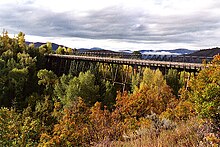Maroon Creek Bridge
[5] When it was built, the Midland was ahead in its race with the Denver and Rio Grande to make the first rail connection to Aspen, then a booming silver mining center.
The Midland had followed the Roaring Fork Valley up from its main line at Glenwood Springs, but was stalled at Maroon Creek by a delay in the bridge steel.
The creek flows through a deep gorge below, roughly 1 mile (1.6 km) upstream of where it drains into the Roaring Fork River to the north.
Its deck is formed from a 73-foot–wide (22 m) single-cell box girder at a constant depth of 13½ feet (4.1 m) with ribbed elements supporting the long slab spans.
Built during a scramble to exploit its silver deposits, it outlasted the railroads that used it to become the main road entrance to Aspen, eventually becoming their only remnant.
Stressed as the city rebounded when it became a popular ski resort, it was later augmented with a modern bridge specifically designed to echo it aesthetically.
What would very quickly become the city of Aspen began as one of several mining camps in the upper Roaring Fork Valley established by prospectors drawn west from Leadville, in the late 1870s.
The mineral veins there had already been thoroughly exploited, and those first settlers defied an order from governor Frederick Walker Pitkin to cross the Continental Divide at Independence Pass into what was still Ute country.
It was not closest to the Divide or the richest deposits, but it had an ample supply of level ground and forests including the trees that gave it its name, which were readily harvested to build the first log cabins.
Two railroads, the Colorado Midland and the Denver & Rio Grande Western, began building routes to the remote city, racing to be the first.
That changed rapidly when James John Hagerman, an Easterner who had already grown rich from mining iron ore in Michigan and silver in Aspen, joined the railroad in 1885.
The next year a new president, David Moffat, changed their minds and the railroad began laying track on the north side of the Roaring Fork, where they did not have to worry about crossing Maroon Creek.
A timber trestle could have been built, but when the crews reached the creek in December they had to wait as the structural steel for Morison's bridge had been delayed leaving its fabricator back East.
They continued working through the difficult mountain winter and completed the bridge in time for the Midland's first train to cross it and arrive in Aspen in February 1888.
The railroad, which had recently built the Busk–Ivanhoe Tunnel, which improved service along its main line, continued operating even as it went bankrupt in 1897, and reemerged as a new company with the same name.
[7] The goal of the widening was to link Aspen with the state's growing road network and thus improve the prospects of the remaining silver miners.
But the onset of the Great Depression stifled any chance of that happening, and both the road and the railroad were primarily used to transport livestock raised by the area's ranchers to market.
He and his wife Elizabeth had found Aspen an ideal place to establish a music festival, and invested heavily in rebuilding the city.
Early in 1947, a special train brought dignitaries from out of town, including one of Colorado's U.S. senators and its governor-elect, to Aspen for a ceremony marking the opening of the new chairlift, at the time the world's longest.
[14] The Rio Grande ran ski trains, which mixed passenger and freight traffic, up to Aspen from its main line at Glenwood Springs.
Over the 1950s the population of Pitkin County grew 44%, due to migration to the upper Roaring Fork Valley, the second highest growth rate on Colorado's Western Slope.
[6] Ranchers began selling their lands for skiing and housing development, some of which became the town of Snowmass, where the workers in Aspen's hotels, restaurants and shops settled, eventually incorporating in the mid-1970s.
Service along the branch was finally abandoned completely when the last coal train left Carbondale in 1994, ending the Roaring Fork Valley's railroad era.
In 2004, after the municipal governments of Aspen and Snowmass decided to fund the design work, CDOT announced that it was expediting the planning process and hoped that construction would begin the following year.
[8] After construction of new road approaches, including designated bus lanes, the new bridge opened in the middle of the year, its final cost almost $14 million.
[20] In late 2010 a body found under the bridge was identified as George Aldrich, a ski-lift operator who had recently moved to Snowmass from Rhode Island.
[21] The county coroner ruled that he had died from injuries sustained in a fall, which had likely occurred when a heavily intoxicated Aldrich accidentally stepped in the gap between the two bridges in the dark.


